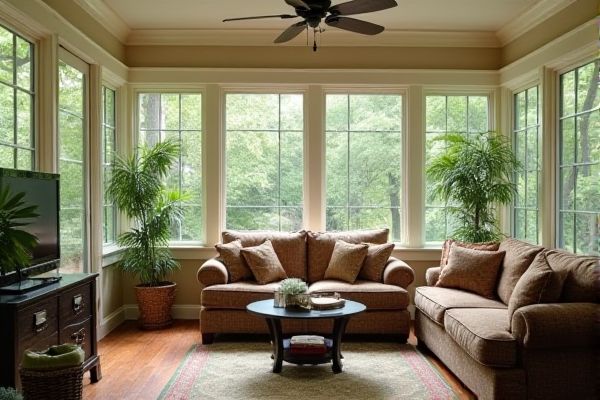
A screened porch offers fresh air and outdoor views while protecting you from insects, whereas a sunroom provides a fully enclosed, climate-controlled space with large windows for year-round enjoyment. Explore the rest of the article to determine which option best enhances your home's comfort and usability.
Table of Comparison
| Feature | Screened Porch | Sunroom |
|---|---|---|
| Structure | Open-air porch enclosed with mesh screens | Fully enclosed room with glass windows and solid walls |
| Purpose | Provides outdoor experience with insect protection | Offers indoor comfort with natural sunlight |
| Climate Control | Limited; typically no heating or cooling | Heated and cooled, suitable year-round |
| Cost | Generally lower cost, simpler construction | Higher cost due to insulation and HVAC integration |
| Usage | Seasonal use, mainly spring to fall | Year-round use regardless of weather |
| Maintenance | Requires regular screen repair and cleaning | Needs window cleaning and occasional HVAC service |
| Lighting | Natural light filtered through screens | Maximized natural light with large glass panels |
Introduction: Understanding Screened Porches and Sunrooms
Screened porches feature mesh panels that provide ventilation and insect protection while maintaining an open-air experience. Sunrooms are enclosed with glass walls and roofs, offering year-round climate control and natural light. Both spaces enhance outdoor living but differ in structure and usability based on weather and comfort preferences.
Key Differences Between Screened Porches and Sunrooms
Screened porches feature mesh screens that allow fresh air and outdoor sounds while keeping insects out, offering a more natural, ventilated experience. Sunrooms are enclosed with glass panels, providing climate control and protection from the elements, making them usable year-round regardless of weather. The choice between a screened porch and a sunroom hinges on desired exposure to outdoor conditions and seasonal usability.
Climate and Seasonal Use Considerations
Screened porches provide excellent ventilation and protection from insects, making them ideal for warm, humid climates and summer use. Sunrooms offer better insulation with glass walls and roofs, allowing year-round enjoyment in cooler or variable climates. Choosing between them depends on the region's temperature extremes and desired seasonal functionality.
Construction Costs: Screened Porch vs Sunroom
Screened porches typically have lower construction costs compared to sunrooms due to simpler materials and fewer structural requirements, with average expenses ranging from $10,000 to $30,000. Sunrooms, featuring insulated glass, heating, and sometimes air conditioning, generally cost between $25,000 and $70,000 because of their complex construction and higher-quality materials. Understanding these cost differences helps your decision-making based on budget constraints and desired home functionality.
Comfort and Protection From the Elements
A screened porch offers excellent ventilation and protection from insects while allowing fresh air to circulate, enhancing comfort during warm weather. A sunroom, enclosed with glass windows, provides superior insulation from wind, rain, and temperature fluctuations, making it usable year-round. Choosing between the two depends on whether you prioritize airflow and outdoor feel or enhanced climate control and weather protection.
Design and Aesthetic Options
Screened porches offer a rustic, open-air design that seamlessly integrates with outdoor landscapes, providing natural ventilation and unobstructed views while maintaining insect protection. Sunrooms feature more versatility with enamel-coated aluminum or wooden frames, expansive glass panels, and a climate-controlled environment, allowing for year-round use and customizable decor options such as skylights or insulated windows. Both structures can enhance curb appeal but sunrooms generally support a broader range of architectural styles and interior finishes compared to the simpler, utilitarian aesthetic of screened porches.
Energy Efficiency and Insulation
Screened porches offer minimal insulation and rely on natural ventilation, making them less energy-efficient compared to sunrooms, which use insulated walls, double-pane windows, and controlled climate systems to maintain indoor temperatures year-round. Sunrooms reduce heating and cooling costs by trapping solar heat during winter and preventing heat loss with thermal barriers, whereas screened porches provide limited protection from outdoor temperature fluctuations. Choosing a sunroom enhances energy efficiency through superior insulation and climate control, ideal for comfortable living spaces regardless of season.
Maintenance and Durability Factors
Screened porches require less maintenance due to their simpler structures and materials that resist weather damage, while sunrooms involve more upkeep because of their glass panels and HVAC systems. Durability depends largely on the quality of materials; aluminum screens and treated wood last longer in screened porches, whereas sunrooms with tempered glass and insulated frames provide better year-round protection. Your choice affects long-term maintenance costs and durability based on local climate and material resilience.
Home Value and Return on Investment
A sunroom typically adds more value to a home than a screened porch due to its year-round usability and climate control features, increasing the overall living space. Homes with sunrooms often see a higher return on investment, frequently recouping 60-70% of the cost upon resale, compared to 40-50% for screened porches. The enhanced natural light and insulation in sunrooms attract more potential buyers, making them a more valuable long-term investment.
Choosing the Right Option: Which is Best for You?
Screened porches offer breathable outdoor living spaces ideal for those seeking insect-free enjoyment and natural ventilation, while sunrooms provide year-round climate control with insulated windows and walls perfect for all-season comfort. Consider your local climate, budget, and intended use: screened porches typically cost less and integrate seamlessly with outdoor environments, whereas sunrooms require higher investment but add valuable square footage and insulation. Evaluate maintenance needs, energy efficiency, and lifestyle preferences to determine whether the casual openness of a screened porch or the enclosed versatility of a sunroom best complements your home and daily activities.
 homyna.com
homyna.com